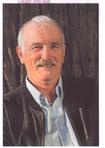John Michael McCarty's Blog, page 13
November 7, 2016
W.W.II in San Francisco, Ch.5
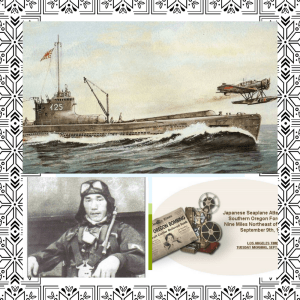 W.W.II in San Francisco took on many different descriptions and tales. This is a continuation of one of those stories. Chapter 5: Long before 9-11 in Manhattan, N.Y., the area east of Brookings, Oregon, was bombed by enemy forces. Nobuo Fujita was a Japanese Warrant Officer who flew a seaplane from the deck of the I-25 submarine aircraft carrier. On September 15, 1942, he dropped incendiary devices, starting a fire in the forests east of Brookings. It has been labeled the “Lookout Air Raid” and goes down in history as the first aerial bombardment of North America.
W.W.II in San Francisco took on many different descriptions and tales. This is a continuation of one of those stories. Chapter 5: Long before 9-11 in Manhattan, N.Y., the area east of Brookings, Oregon, was bombed by enemy forces. Nobuo Fujita was a Japanese Warrant Officer who flew a seaplane from the deck of the I-25 submarine aircraft carrier. On September 15, 1942, he dropped incendiary devices, starting a fire in the forests east of Brookings. It has been labeled the “Lookout Air Raid” and goes down in history as the first aerial bombardment of North America.
There were eleven Jap subs creating chaos off the West Coast to give the illusion that an invasion was soon at hand. Most believed that the Japanese Imperial Navy would continue on from their victory at Pearl Harbor and strike at San Diego and/or San Francisco. In addition, the I-25 is credited with bombing Fort Stevens near Astoria, the Ellwood oil fields of Santa Barbara and several merchant ships. The vessel also slipped past the anti-sub nets of the Golden Gate and attempted to torpedo the U.S.S. Lexington, moored at Hunters Point shipyard.
Nobuo Fujita:
Nobuo Fujita visited Brookings, Oregon, in 1962 after receiving assurance that he would not be tried as a war criminal. He carried his samurai sword with the intention of committing seppuku if all did not go well. The town, however, made him an honorary citizen (not without some controversy). His family’s 400-year-old sword now resides in the local museum. Nobuo Fujita started a student exchange program between Brookings and Tokyo that still flourishes today. He passed away in 1997.
This Thursday we will take a closer look at the Japanese submarine aircraft carrier. Until then, keep turning those pages. Cheers!
The post W.W.II in San Francisco, Ch.5 appeared first on John McCarty.
November 3, 2016
W.W.II in San Francisco, Ch.4
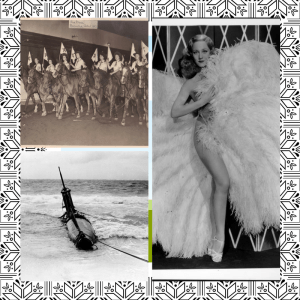 W.W.II in San Francisco took on many different descriptions and tales. This is a continuation of one of those stories. Chapter 4:
W.W.II in San Francisco took on many different descriptions and tales. This is a continuation of one of those stories. Chapter 4:
In 1942 my mother, Anne Klausen, in an effort to please her father, Elmer Klausen, quit the S.F. Ballet and Opera Company and joined the equestrian unit of the Red Cross, riding Spencer Tracy’s polo pony. Her days were filled with routine excursions out in the Sunset and Richmond dunes, reminding the hobo “towns” to not start any fires at night. One day she discovered an abandoned minisub on Ocean Beach. It was later identified as belonging to the I-25, a Japanese submarine aircraft carrier. But where did its operators go? Records did not list them as being captured. Did they hook up with San Francisco’s Japantown? Or was it with the Black Dragon Society of espionage insurgents?
Music Box:
On my mother’s days off, she pretended to volunteer as a Block Warden. She even borrowed a uniform. But what she was secretly doing with this time was dancing at Sally Rand’s Music Box down on O’Farrell Street (same building as the present day Great American Music Hall). Sally Rand had a bit of a reputation. The inventor of the fan dance was arrested for riding naked on horseback down the main corridor of the ’33 Chicago World’s Fair. She also organized Sally Rand’s Nude Ranch at the Golden Gate International Expo in ’39 on Treasure Island. Anne’s father, Elmer, would not have approved, but his daughter was desperate to seek any venue in which to further her dancing career. She added a little class to the club, incorporating her ballet moves into the more risque skits of burlesque. But her ambitious schedule would get very interesting when Elmer started visiting the Music Box to woo the affections of Sally Rand herself.
Next Monday, Nov. 7th, we’ll take a peek at the first aerial bombardment of North America. Until then, keep turning those pages, my friends.
The post W.W.II in San Francisco, Ch.4 appeared first on John McCarty.
October 31, 2016
W.W.II in San Francisco, ch. 3
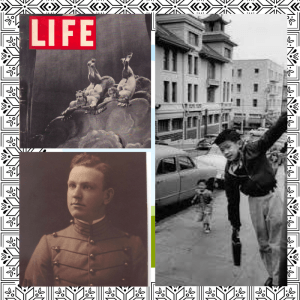 W.W.II in San Francisco came in the form of many different descriptions and tales. This is the continuation of one of those stories. Chapter Three:
W.W.II in San Francisco came in the form of many different descriptions and tales. This is the continuation of one of those stories. Chapter Three:
My mother, Anne Klausen, was photographed in the 1937 issue of Life magazine as the youngest member of the S.F. Ballet and Opera Company at age fifteen. By the time Pearl Harbor came around, she was a bold and sassy nineteen-year-old and out of work. The Opera House had closed down and Anne was looking to further her career. Her father, Elmer Klausen (my grandfather), argued with her to do something patriotic for her country rather than standing around on her tiptoes.
Brash and independent, she would lash back saying that his participation in the California Grays was nothing more than the work of a bunch of vigilantes. History would prove her right. One night in the early part of 1942, before the Japanese internment camps had been OK’d by the boys in Washington, the Grays assembled at the unofficial request of Lt. Gen. John L. DeWitt, commander of the Fourth Army at the Presidio.
California Grays:
Lt. Gen DeWitt once said, “Death and destruction are likely to come to this City at any moment.” To do his dirty work, he enlisted the services of the California Grays who were beholding to no government agency. Without his daughter’s knowledge, Elmer Klausen and his vigilante pals instituted a raid on Japantown at the northern end of the Western Addition and boarded up the Shinjuku-ku Language School. There was a brief standoff between the Grays and a batch of young Nisei (American born Japanese) before the militia group made there way down the block to the sound of a bansho bell. The Grays stormed the temple where the Manjusri asked for calm. The California Grays searched the premises and uncovered several maps of West Coast cities as well as a short-wave radio. To the vigilantes and others, the raid proved that Japantown was working closing with the covert insurgent group known as the Black Dragon Society.
This Thursday, Anne finds work as a burlesque dancer down at Sally Rand’s Music Box, unbeknownst to her father.
The post W.W.II in San Francisco, ch. 3 appeared first on John McCarty.
October 27, 2016
W.W.II in San Francisco, Ch.2
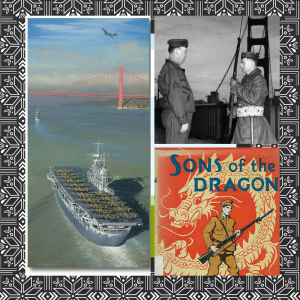 W.W.II in San Francisco came in the form of many different descriptions and tales. This is the continuation of one of those stories. Chapter Two:
W.W.II in San Francisco came in the form of many different descriptions and tales. This is the continuation of one of those stories. Chapter Two:
At 08:48 hours on April 2nd, 1942, the outbound U.S.S. Hornet approached the Golden Gate Bridge with its cargo of Doolittle’s sixteen U.S. Army Air Force B-25 Mitchell bombers. A civilian fishing trawler hauled back the anti-submarine net. Tensions were high. The Japanese were winning the battle in the Pacific while the fear of enemy insurgents had shaken the heart and soul of civilians and military at home. The Black Dragon Society (Kokwryukai) had been formed in 1901 to serve the Japanese Empire at all costs. It was a paramilitary, right-wing group that had infiltrated the West Coast of the United States, blending into the Japantowns of Seattle, San Francisco and Oakland.
My biological grandfather, Sergeant Elmer Klausen, a member of the California Grays (a militia group with a checkered past), posted a National Guardsman at the southend of the bridge.
W.W.II: April 2nd, 1942:
The antenna of the aircraft carrier was lowered to ease its passage beneath the Golden Gate. Without warning, a gunshot was heard from the nearby tower. Sergeant Klausen rushed toward the alarm. A hooded figure dressed in black appeared from the fog. The Sergeant ordered the person to halt and fired a warning from his Winchester, but the mystery person sprinted away, disappearing bit by bit into the mist. The Sergeant leaned over the railing, inspecting the deck of the Hornet for any damage. All appeared normal. Good. In an impulse, he turned and creaked open the steel door of the tower. The dead body of the National Guardsman lay limp before him. An MP soon arrived followed by an ambulance. The sight of the soldier in a body bag sent Sergeant Klausen to seek quiet. On the other side of the tower, he found a nine-inch, curved knife with exotic foreign characters written on its handle. A calling card? W.W.II: April 2nd, 1942.
Next Monday, we’ll join my grandfather, Elmer Klausen, as he and his vigilante pals orchestrate an illicit raid upon San Francisco’s Japantown. Stay tuned. Cheers!
The post W.W.II in San Francisco, Ch.2 appeared first on John McCarty.
October 24, 2016
W.W.II in San Francisco
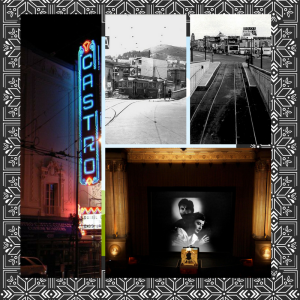 W.W.II in San Francisco took on many different shapes and sizes. This is one of those stories.
W.W.II in San Francisco took on many different shapes and sizes. This is one of those stories.
On the morning of December 7th, 1941, a trolley exited the Twin Peaks tunnel, dragging sparks from the overhead wires. Anne Klausen disembarked and crossed three lanes of traffic against the light. A Hudson tooted and smoked to a halt, but Anne didn’t hear the complaint. She stomped along, thinking about her vigilante dad, cussing him out in silent rage. Anne entered an Art Deco building where blue neon letters read CASTRO. The marquee heralded the feature attraction, The Maltese Falcon. The images of Humphrey Bogart and Mary Astor, however, did little to extinguish the gnashing inside her head. Anne ordered some popcorn from a cashier, blabbing about how a father who was a regular down at Sally Rand’s strip club had no right lecturing his daughter on Catholicism and such nonsense.
December 7th, 1941:
The cashier corkscrewed his face, handed the teenager her treat and called out “next”. Anne Klausen climbed a carpeted staircase and slouched into a seat. The Wurlitzer organ played a haunting tune as Sam Spade whirled his lover around and said, “I don’t care who loves you, I won’t play the sap for you anymore.” But before his beloved could answer, a squatty man with a Hitchcock paunch marched onto the stage, signaling for another to turn on the houselights. In a husky voice, he asked for everyone’s attention. A murmur rose from the puzzled patrons as the manager directed all to the exits, that Lieutenant General John L. DeWitt, commander of the Fourth Army at the Presidio, has announced that the Japanese have attacked Pearl Harbor. December 7th, 1941.
Next time, Anne Klausen’s father and his militia group assist the National Guard in manning the Golden Gate Bridge where panic brings the first casualty of W.W.II.
The post W.W.II in San Francisco appeared first on John McCarty.
October 14, 2016
Sonoma County Art Trails – Final Weekend
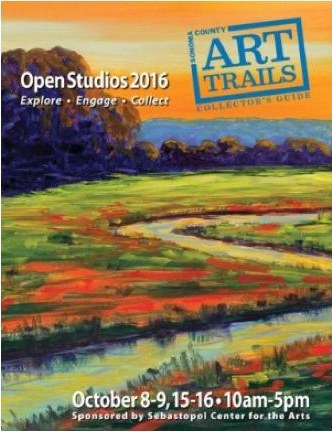
Final weekend, you can have a look at some of the best art that Sonoma County has to offer. Art Trails provides a chance to visit the artists’ studios and watch works in progress. The Sebastopol Center for the Arts, the largest art center in California, north of San Francisco, will host a preview exhibit of a piece of work from each Art Trail artist, from Sept. 23 – Oct. 16.
Cost:
Free
Location:
Various Sonoma County Art Studios
Sebastopol Center for the Arts
282 S. High Street
Sebastopol, California 95472
For More Information:
Contact: Sebastopol Center for the Arts
Local: 707-829-4797
Email: info@sebarts.org
The post Sonoma County Art Trails – Final Weekend appeared first on John McCarty.
October 13, 2016
Northwood Golf Stories, Monte Rio
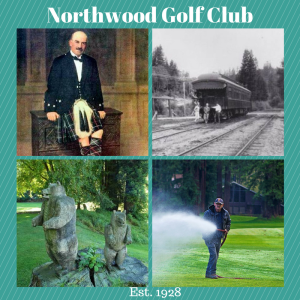 Northwood golf stories know no boundary. It all began with Alister Mackenzie who built the Russian River gem in 1928. He supposedly refused quarters at the nearby Bohemian Grove and chose instead to stay in a railroad car. The black ‘n’ white photo shows Alister standing near his preferred “lodging” at Northwood, which was the end of the line for the Northwestern Pacific Railroad. Just out of the reach of the local gendarmes, the temporary residence soon became the hangout for local card sharks, distillation entrepreneurs, and ladies of the night. And all this time you thought he was a proper gentleman. Oh my!
Northwood golf stories know no boundary. It all began with Alister Mackenzie who built the Russian River gem in 1928. He supposedly refused quarters at the nearby Bohemian Grove and chose instead to stay in a railroad car. The black ‘n’ white photo shows Alister standing near his preferred “lodging” at Northwood, which was the end of the line for the Northwestern Pacific Railroad. Just out of the reach of the local gendarmes, the temporary residence soon became the hangout for local card sharks, distillation entrepreneurs, and ladies of the night. And all this time you thought he was a proper gentleman. Oh my!
Contemporary tales tell of wayward golf shots that caused much consternation. More than a few motorists have levied complaints with the pro shop, telling of white orbs hitting their vehicle on Highway 116. One such object evidently bounced from one auto to the next, ping-ponging off eight total, finally nesting in the sidecar of a W.W.II motorcycle.
Northwood Golf Stories:
Another Northwood golf story features an ex-pro wrestler. He’s a big strong guy, weighing in at nearly 275lbs, standing 6’5″. All muscle, or so he says. There are differences of opinion on the later. It must be noted that this gentleman’s strength had enabled him at one time to reach the green from the seventh tee, a distance of some 380 yards! Back to our narrative. The hulk took a mighty swing and launched the ball, arms and torso churning up high powered torque. The ball, however, hit the forward red tee block, careened ninety degrees right, sped across the adjoining ninth fairway some seventy yards, broke the outer pane window of a house, bounced off the inner pane of the same double-glass porthole, and landed back in play. No penalty! More stories to come. Stay tuned. Cheers!
The post Northwood Golf Stories, Monte Rio appeared first on John McCarty.
October 6, 2016
Northwood Golf Course in Monte Rio
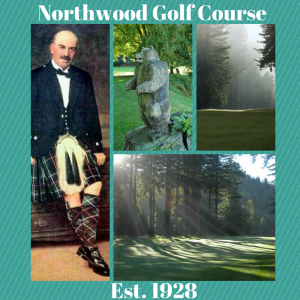 Northwood Golf Course in Monte Rio features the magic of architect Dr. Alister MacKenzie. He was a friend of Bohemian Jack Neville who was five-time California state amateur champion and a member of the 1923 Walker Cup team. Neville persuaded the Brit to build a nine hole course on the seventy wooded acres across the Russian River from the Bohemian Grove. Following construction of Northwood Golf Course in 1928, there was a succession of owners including the Korbel family. A pedestrian bridge (remnants of which are still there if you look closely) connected the Grove to the Korbel vacation home on Redwood Drive where Bohemians would play cards, hold socials and taste local delicacies.
Northwood Golf Course in Monte Rio features the magic of architect Dr. Alister MacKenzie. He was a friend of Bohemian Jack Neville who was five-time California state amateur champion and a member of the 1923 Walker Cup team. Neville persuaded the Brit to build a nine hole course on the seventy wooded acres across the Russian River from the Bohemian Grove. Following construction of Northwood Golf Course in 1928, there was a succession of owners including the Korbel family. A pedestrian bridge (remnants of which are still there if you look closely) connected the Grove to the Korbel vacation home on Redwood Drive where Bohemians would play cards, hold socials and taste local delicacies.
Across the street and close to the ninth green still stands one of the earliest pro shops of Northwood (private residence now). Its old charcoal stove, cleat-marked wooden floors and snooker table remind us of another era.
Northwood Golf Course:
In 1960 the Northwood Development Corporation began selling lots. Roads and homes were built, removing some 300 yards from Northwood Golf Course. For example, the No. 1 tee box was originally located some seventy yards further back (no restaurant at the time) while No. 2 was a daunting 440-yard par four. Other local MacKenzie course are the Meadow Club (Fairfax), Claremont Country Club (Oakland), Sharps Park (Pacifica), and Green Hills Country Club (Millbrae). According to the Forestville Historical Society, he also created the Russian River Golf & Country Club (also known as the Cosmo Golf Course and the Hacienda Golf & Country Club), which at one time was located northwest of the Hacienda Bridge on McPeak Road near the old Skippy’s restaurant. Today, the Schaap and Bale families have restored the course to much of its original magnificence, prompting Golf Magazine to rank Northwood at #3 nationally including both public and private nine hole courses. Our own little gem. Hoorah for us!
The post Northwood Golf Course in Monte Rio appeared first on John McCarty.
Alister MacKenzie Golf Courses in the Bay Area
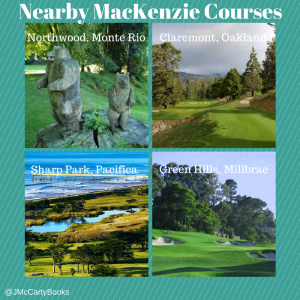 Alister MacKenzie golf courses in the Bay Area include Sharp Park (Pacifica), Claremont Country Club (Oakland), Green Hills Country Club (Millbrae), Northwood Golf Course (Monte Rio), and Meadow Club (Fairfax). He is best known for Augusta National (Georgia) and Cypress (Monterey), which at one time was ranked #4 in the U.S. Sports Illustrated called him “golf’s greatest architect.”
Alister MacKenzie golf courses in the Bay Area include Sharp Park (Pacifica), Claremont Country Club (Oakland), Green Hills Country Club (Millbrae), Northwood Golf Course (Monte Rio), and Meadow Club (Fairfax). He is best known for Augusta National (Georgia) and Cypress (Monterey), which at one time was ranked #4 in the U.S. Sports Illustrated called him “golf’s greatest architect.”
Although born near Yorkshire, England, his strong identification with his Scottish roots featured prominently in many aspects of his later life. In 1897 he graduated from Cambridge University with a Bachelor of Surgery. He served as a doctor during the Boer War in South Africa where he became fascinated with the camouflage techniques of the enemy. As a result, he surrendered his medical practice during World War I and became a camoufleur, making the best use of natural cover.
Alister MacKenzie:
Alister MacKenzie’s experience during W.W.I influenced his golf course creations, which became noted for their sensitivity to the immediate surroundings. His greens undulate with the given terrain, sloping from front to rear, which allowed golfers to play a links-like punch-shot on approach. The greens are also often angled from the center of the fairway for a more “natural” look with fairly large and free-form bunkers. Alister MacKenzie passed away in January of 1934 and is buried near Pasatiempo Golf Course in Santa Cruz, which he also designed and lived on for a while.
The post Alister MacKenzie Golf Courses in the Bay Area appeared first on John McCarty.
September 27, 2016
The Historic Louvre Saloon in Guerneville
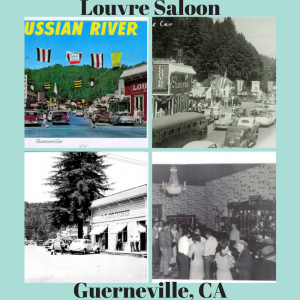 The historic Louvre Saloon in Guerneville along the Russian River was once the most popular watering hole in the area. Located on the northwest corner of Main Street and Armstrong Woods Road, it served the best spirits from the 1880’s into the 1960’s. The building still stands, having housed the Russian River Video store for twenty-five years and presently the Community First Credit Union.
The historic Louvre Saloon in Guerneville along the Russian River was once the most popular watering hole in the area. Located on the northwest corner of Main Street and Armstrong Woods Road, it served the best spirits from the 1880’s into the 1960’s. The building still stands, having housed the Russian River Video store for twenty-five years and presently the Community First Credit Union.
The Guerneville & Russian River R.R. Line (an addition to the San Francisco & North Pacific R.R.) used to transport passengers to the Louvre Saloon’s front steps from the ferry building in Sausalito. An outdoor beer garden (circa 1920’s) was located across the street while inside there was a card room in the rear with rumors of one-arm bandits stationed nearby to relieve you of your money. In more recent times, boxing great Carl Bubba Olsen used to receive free libations in exchange for the saloon using his name for promotional reasons.
Louvre Saloon:
The Louvre Saloon has gone the way of other established businesses in Guerneville. Meeting a similar fate was the old Mercantile across the street, which was sold recently to a wealthy investor from San Francisco who might have intentions of turning it into a B&B. True? Outside money is pouring into the little hamlet, and the town seems to be divided on the merits of such monetary infusion. On the one hand you have the N.Y.Times, Sunset, and AAA all touting Guerneville as a “food destination”. A documentary film titled Main Street Empire will be coming soon to a theater near you. The tourists are flooding in, “no vacancy” signs are common on the summer weekends. Good, right? On the other hand, you have longtime locals fearing that their small shops may not be able to withstand future rent hikes and necessary upgrades while jobs go to outsiders. What do you think? Yea or nay?
The post The Historic Louvre Saloon in Guerneville appeared first on John McCarty.

